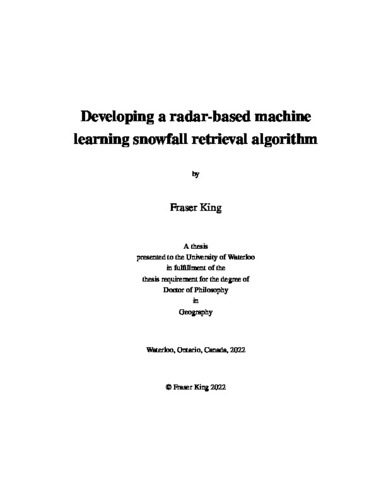| dc.description.abstract | As global temperatures continue to rise, snowfall patterns are expected to respond in a complex, nonlinear manner. Changes in the quantity of snowmelt-derived freshwater will impact global water-energy budgets, flood frequencies and intensities, and regional water resource management practices. Remote sensing is an observational alternative to poorly constrained reanalysis-derived estimates of snow water equivalent (SWE) across Arctic regions. We present an outlier detection methodology which leverages remote sensing data from CloudSat to constrain reanalysis product estimates of SWE. This analysis highlights areas and periods of high uncertainty in the gridded reanalysis datasets, and identifies a systematic positive SWE bias (of 14.9%) in a blended reanalysis product as a consequence of these low-quality estimates. The ability to use remotely sensed observations to characterize error in surface SWE estimates is incredibly powerful, however, remote sensing datasets are not without their own sources of uncertainty. This work also, therefore, examines the capabilities of a machine learning snowfall retrieval algorithm trained on vertically pointing surface radar data at a Global Precipitation Measurement (GPM) validation experiment site in southern Ontario. Random forest (RF) retrieval performance is compared to an ensemble of traditional Ze-S power law relationships, with the RF consistently displaying the lowest overall error. The RF also demonstrates a level of robustness not present in the power law relations, with low error when applied to unseen observations from a study site with a different regional climate. We further extend this methodology to a general machine learning precipitation retrieval across the wider northern hemisphere (NH) using additional input covariates, data from multiple sites over a longer time period, and by adopting a more sophisticated deep learning paradigm. The DeepPrecip retrieval algorithm displays a 187% improvement in snowfall retrieval accuracy when compared to traditional Ze-S/R power law relationships, and a 21% improvement over the aforementioned RF. The highly generalized nature of DeepPrecip facilitates its application to unseen data with only a small performance reduction. DeepPrecip also provides insight into the regions of the vertical column (below 1 km and between 1.5−2 km) most effective in contributing to high retrieval accuracy, highlighting the important role of ML in current and future spaceborne remote sensing precipitation missions. | en |

